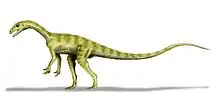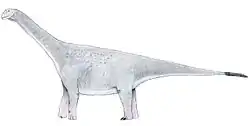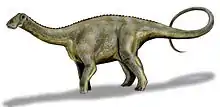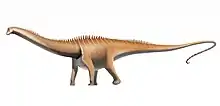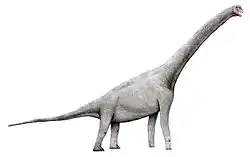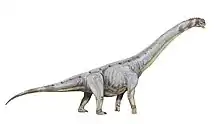Dicraeosaurus
Dicraeosaurus (Gr. δικραιος, dikraios "bifurcated, double-headed" + Gr. σαυρος, sauros "lizard") is a genus of small diplodocoid sauropod dinosaur that lived in what is now Tanzania during the late Jurassic. It was named for the spines on the back of the neck. The first fossil was described by paleontologist Werner Janensch in 1914.
| Dicraeosaurus | |
|---|---|
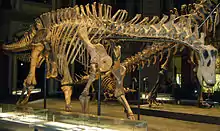 | |
| Dicraeosaurus skeleton | |
| Scientific classification | |
| Kingdom: | Animalia |
| Phylum: | Chordata |
| Clade: | Dinosauria |
| Clade: | Saurischia |
| Suborder: | †Sauropodomorpha |
| Clade: | †Sauropoda |
| Clade: | †Eusauropoda |
| Clade: | †Neosauropoda |
| Family: | †Dicraeosauridae |
| Subfamily: | †Dicraeosaurinae Janensch, 1929 |
| Genus: | †Dicraeosaurus |
| Type species | |
| †Dicraeosaurus hansemanni | |
| Species | |
| |
Description

Unlike most diplodocoids, Dicraeosaurus had a large head with a relatively short and wide neck. The neck contained 12 unusually short vertebrae, so it could probably browse vegetation only from ground level to a height of about 3 metres (9.8 ft).[1] It also lacked the whiplash tail that other diplodocids had. It was smaller, at only reached 12 metres (39 ft) in length. It gets its name, which means two-forked lizard, from the spines that came from the vertebrae. They were not straight as in some members of the family. Each one was “Y” shaped, like a fork. These spines also provided muscle attachment points.[2]
Classification

The following cladogram follows an analysis by Sereno et al. in 2007.[3]
| Diplodocoidea |
| |||||||||||||||||||||||||||||||||||||||||||||||||||||||||||||||||||||
Palaeoecology
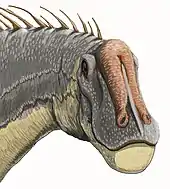
Dicraeosaurus lived in the Late Jurassic. It was herbivorous; however, it didn't compete with other dinosaurs for vegetation. Fossils have been discovered in the rocks of Tendaguru Hill in Tanzania. The rocks also yield fossils of Giraffatitan and Kentrosaurus. As there was a distinct difference in size between these animals, they would probably have browsed for vegetation at different levels, allowing them to co-exist without significant competition.[2]
References
- Benton, Michael J. (2012). Prehistoric Life. Edinburgh, Scotland: Dorling Kindersley. p. 270. ISBN 978-0-7566-9910-9.
- Palmer, D., ed. (1999). The Marshall Illustrated Encyclopedia of Dinosaurs and Prehistoric Animals. London: Marshall Editions. p. 132. ISBN 1-84028-152-9.
- Sereno PC, Wilson JA, Witmer LM, Whitlock JA, Maga A, et al. (2007) Structural Extremes in a Cretaceous Dinosaur. PLoS ONE 2(11): e1230.
